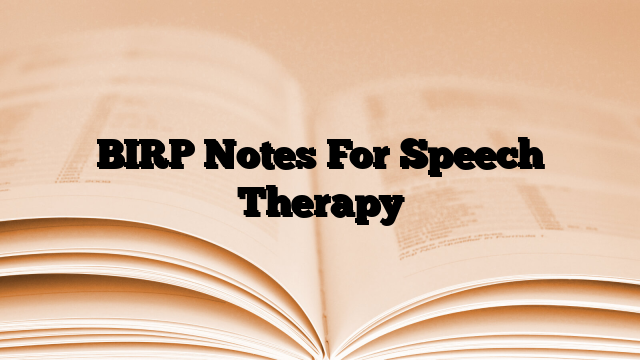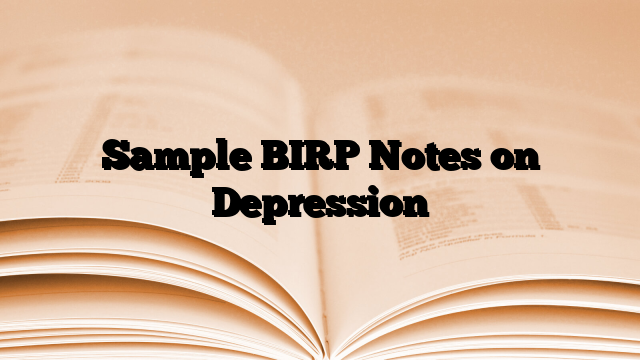Speech therapy is a critical intervention for individuals with communication disorders. Accurate and efficient documentation of each session is essential for tracking progress, planning future sessions, and communicating with other healthcare professionals. This is where BIRP notes come into play. BIRP (Behavior, Intervention, Response, and Plan) is a format widely used in health and therapy fields for note-taking. This guide explores how BIRP notes can be effectively utilized in speech therapy.
Importance of BIRP Notes in Speech Therapy
BIRP notes can play an important role in speech therapy, offering a systematic approach to documenting sessions, tracking progress, and facilitating effective communication among healthcare professionals and clients.
- Progress Tracking: BIRP notes provide a structured way to monitor a client’s progress over time.
- Communication Tool: They serve as a crucial communication medium between therapists, clients, and other healthcare professionals.
- Accountability and Legal Documentation: These notes act as a record of the therapy provided, which is important for accountability and legal purposes.
Writing Effective BIRP Notes in Speech Therapy
Here are some tips for writing effective birp notes for speech therapy.
- Clarity and Conciseness: Notes should be clear and to the point, avoiding unnecessary jargon.
- Specificity: Be specific about behaviors, interventions, responses, and plans. Vague descriptions can lead to misunderstandings.
- Objectivity: Record observations without personal bias. Focus on observable behaviors and measurable outcomes.
- Consistency: Consistent documentation helps in tracking progress and identifying patterns over time.
Case Example
To illustrate, consider a child with articulation disorder.
- Behavior: “Client was attentive but showed frustration with difficult sounds.”
- Intervention: “Used tactile cues and visual feedback to practice /s/ and /z/ sounds.”
- Response: “Client successfully produced /s/ in isolation but struggled in syllables.”
- Plan: “Next session to focus on syllable-level practice. Suggested home exercises with flashcards.”
Challenges and Solutions in BIRP Note Writing
You might face some challanges in birp note writing for speech therapy. Here are some common challanges and their solutions:
- Time Constraints: Speech therapists often have back-to-back sessions. Solution: Develop a template or use speech therapy-specific software for quicker note-taking.
- Maintaining Client Confidentiality: Always adhere to privacy laws and regulations when documenting and storing notes.
Adapting BIRP format in Speech Therapy
Here’s how you can adapt the BIRP format for your speech therapy sessions:
B – Behavior:
- Speech: Describe the client’s current speech abilities, including articulation, fluency, vocabulary, grammar, and comprehension. Note any specific behaviors you’re targeting, such as stuttering, lisping, or difficulty with certain sounds.
- Language: Assess the client’s expressive and receptive language skills. Describe their abilities to understand and use language in different contexts.
- Communication: Observe and document the client’s overall communication skills, including nonverbal communication, pragmatics (social use of language), and participation in conversations.
I – Intervention:
- Specific techniques: Record the speech therapy techniques you used during the session, such as articulation drills, language stimulation activities, fluency shaping strategies, or social communication interventions.
- Materials: Document the materials you used, such as flashcards, worksheets, games, or assistive technology.
- Modifications: Note any adaptations or modifications you made to the therapy activities to meet the client’s individual needs.
R – Response:
- Client response: Describe the client’s engagement and response to the intervention. Did they understand the task? Were they able to participate actively? Did they make any progress towards their goals?
- Progress monitoring: Use specific data points or objective measures to track the client’s progress, such as number of correctly produced sounds, increased vocabulary size, or improved conversational skills.
- Challenges: Note any challenges or obstacles encountered during the session that may need to be addressed in future sessions.
P – Plan:
- Goals: Reiterate the short-term and long-term goals for the client’s speech therapy.
- Homework: Assign any home practice activities or exercises to reinforce the skills learned in the session.
- Next steps: Outline the plan for the next session, including activities, materials, and modifications.
- Collaboration: Indicate any communication needed with other professionals involved in the client’s care, such as teachers, parents, or other therapists.
Additional Tips:
- Use concise and objective language when documenting your observations.
- Focus on observable behaviors and measurable outcomes.
- Include qualitative notes to give a more complete picture of the session.
- Regularly review and update the BIRP notes to track progress and inform future interventions.
BIRP Notes: Speech Therapy Session (Example)
Client Information
- Name: [Client’s Name]
- Date: [Session Date]
- Therapist: [Therapist’s Name]
- Session Number: [Number]
Behavior
- Observation: The client arrived on time, appearing eager but slightly anxious. Initially hesitant to engage in exercises involving new vocabulary, the client gradually became more comfortable.
- Mood: Initially reserved, progressing to cooperative and engaged.
- Participation: Active participation observed, especially in interactive activities.
Intervention
- Techniques Used:
- Articulation drills focusing on /r/ and /l/ sounds.
- Language stimulation activities incorporating new vocabulary.
- Use of picture cards to facilitate word recognition and pronunciation.
- Interactive storytelling to enhance narrative skills.
- Duration: Each exercise lasted approximately 10 minutes, with breaks as needed.
Response
- Client’s Reaction:
- Showed improvement in articulating /r/ sounds, with occasional lapses in clarity.
- Demonstrated enthusiasm in language stimulation activities, effectively using new words.
- Responded well to visual aids, showing increased accuracy in word recognition and pronunciation.
- In storytelling, the client was able to construct simple narratives with minimal prompting.
- Progress Notes:
- Continued difficulty with /l/ sound, requiring further practice.
- Significant engagement and progress in vocabulary expansion.
Plan
- Next Steps:
- Intensify focus on /l/ sound articulation in the next session.
- Introduce more complex words in language stimulation exercises.
- Incorporate multi-sensory approaches to enhance word recognition skills.
- Homework:
- Practice articulation drills provided in the handout.
- Engage in daily reading, emphasizing new vocabulary.
- Record and listen to their own storytelling sessions to self-evaluate narrative skills.
- Goals for Next Session:
- Achieve more consistent clarity in /l/ sound articulation.
- Expand vocabulary by at least ten new words.
- Enhance narrative construction in storytelling activities.
Additional Notes
- Observations for Future Reference: The client shows increased confidence with familiar exercises; introducing new challenges gradually may yield better results.
- Collaboration with Parents/Caregivers: Recommended to encourage daily reading and practice sessions at home to reinforce learning.
The Botton Line:
BIRP notes are an invaluable tool in speech therapy, providing a structured and comprehensive method for documenting client sessions. They enhance the therapist’s ability to track progress, tailor interventions, and communicate effectively with other healthcare professionals. By clearly detailing behaviors, interventions, responses, and future plans, BIRP notes ensure a consistent and focused approach to speech therapy. Adopting this method can significantly improve therapeutic outcomes and support the overall journey of individuals towards better communication skills, making it an essential practice for speech therapists.






